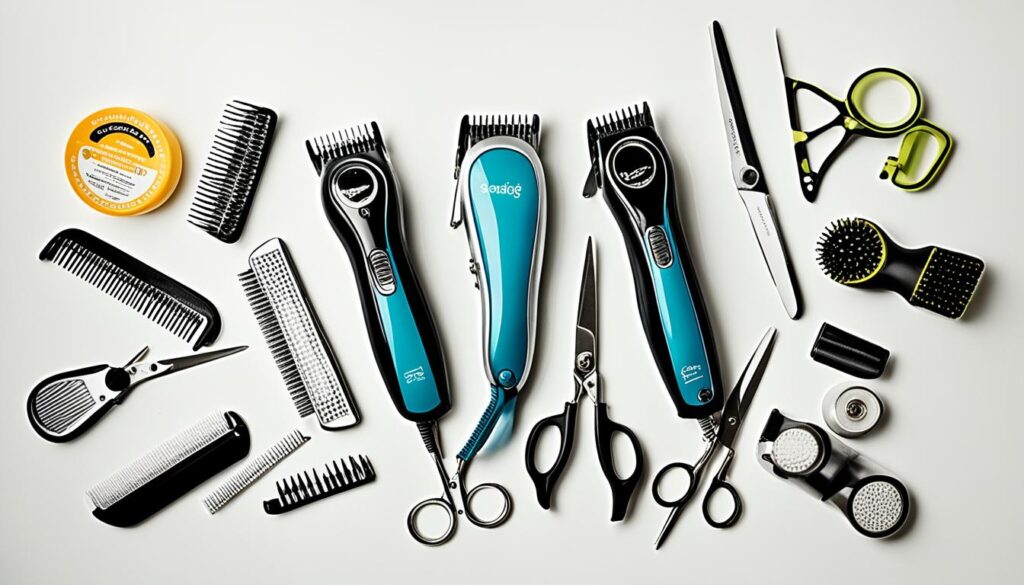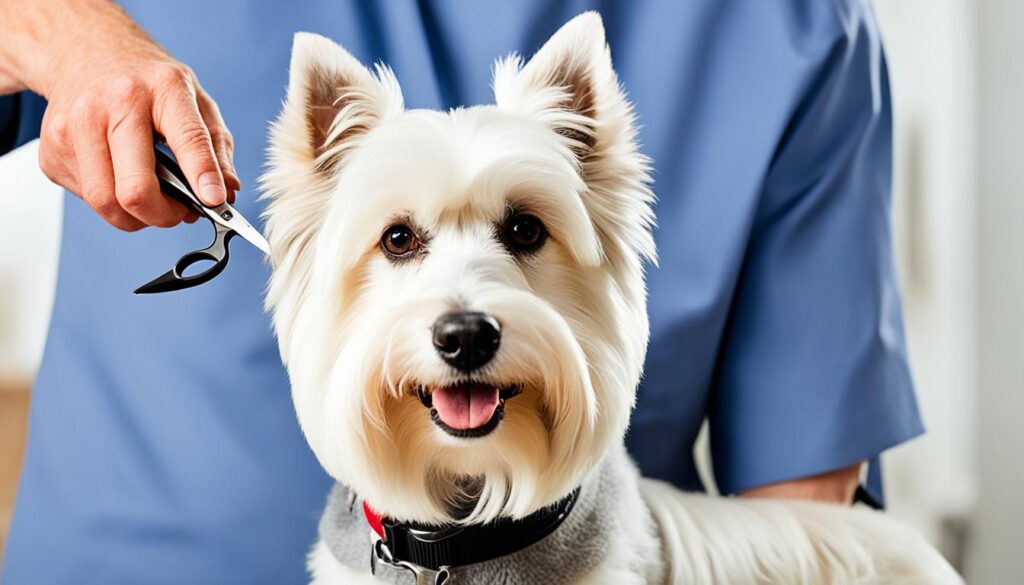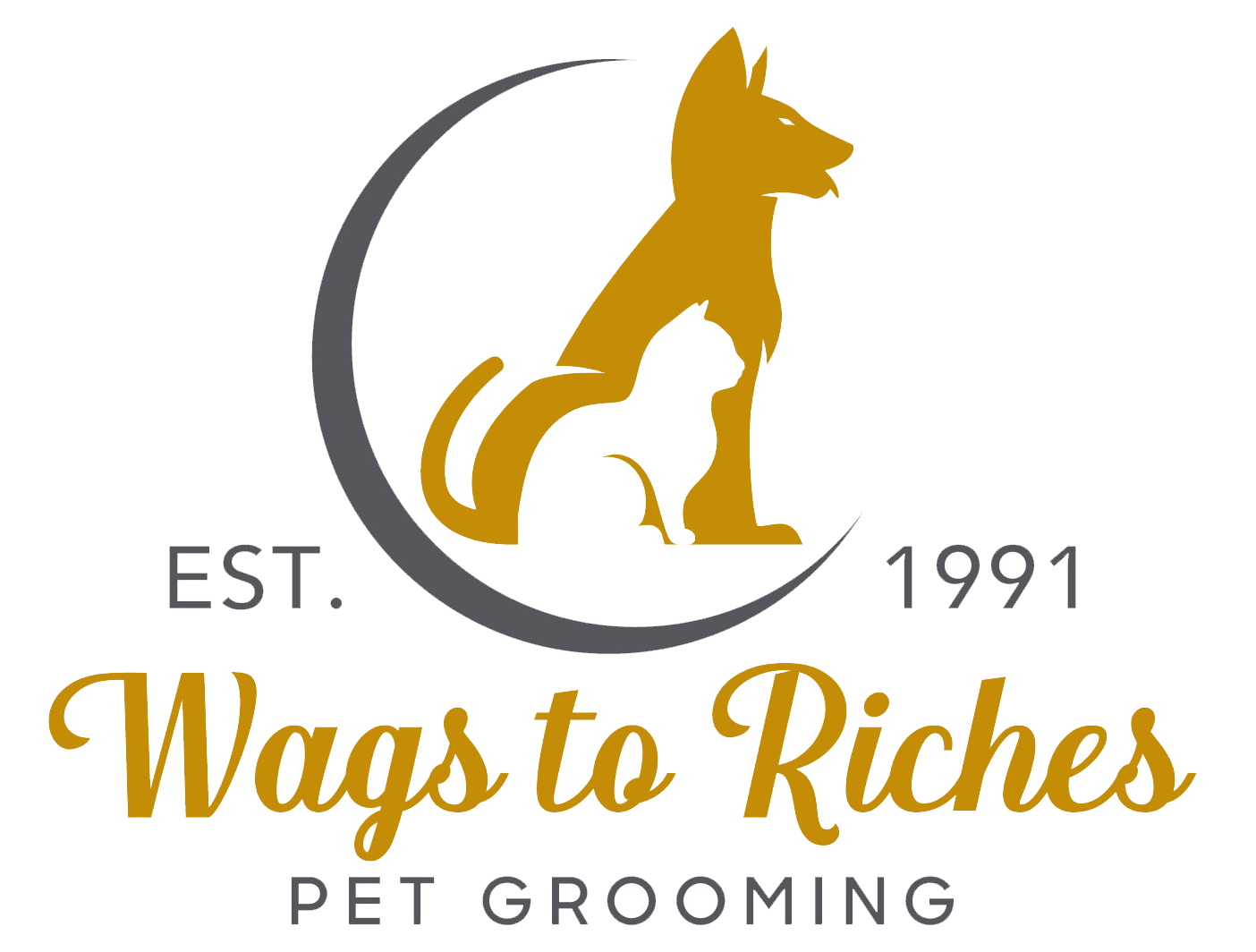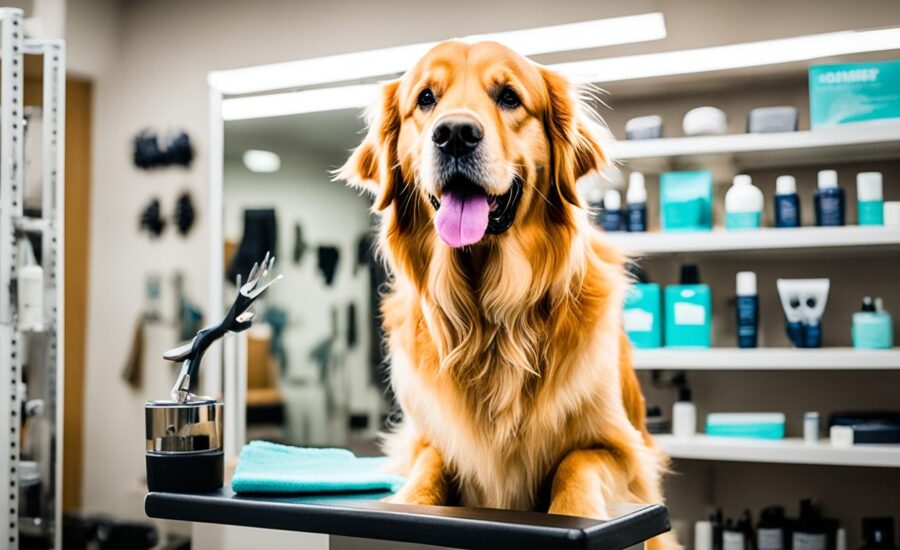Keeping your pet comfortable and healthy is important. Grooming is more than just a routine; it greatly affects their well-being. Our pet grooming guide provides essential tips for safe pet grooming practices. It focuses on grooming your pet’s face and head. You’ll learn how to trim fur around their eyes and keep them clean, keeping tails happily wagging.
It’s key to know your pet’s grooming needs. Breeds with long facial hair need extra care to prevent irritation or vision problems. We’ll show you safe and effective grooming methods. Whether it’s a gentle brush-out or a careful trim, you’ll learn how to groom your pet safely.
Let’s explore how to choose the right tools and use gentle techniques. We want pet grooming, especially of the head and face, to be a comforting experience, not a chore.
Key Takeaways
- Recognize the impact and necessity of regular grooming on your pet’s health and comfort.
- Learn about the tools that promote safe pet grooming practices for face and head grooming.
- Discover the importance of personalized grooming for different breeds.
- Understand how to prepare your pet for a stress-free grooming session.
- Grasp specialized trimming techniques for sensitive areas like eyes and ears.
- Get guidance on maintaining your pet’s muzzle and beard for optimal hygiene.
Introduction to Pet Grooming at Home
Diving into pet grooming tips can change your pet’s look and health. Learning to groom your pet at home is important. It depends on your pet’s breed and how they behave.
The Importance of Regular Facial Grooming for Pets
Grooming is crucial for your pet’s health, not just their looks. Pets with long face hair need it often to see and eat well. Clean faces also stop eye problems and keep dirt and germs away.
Understanding Your Pet’s Grooming Needs
Every pet is different and so are their grooming needs. Some breeds might need haircuts to see better. Others need regular brushing to avoid tangles. Good grooming keeps your pet healthy and helps find skin problems early. With the right grooming pets at home advice, your pet will be healthier and happier.
Choosing the Right Pet Grooming Tools
Having the right pet grooming tools is key to good pet care at home. Each tool has specific benefits. They help perform pet grooming techniques well. This keeps your pet both looking and feeling great. Tools like thinning scissors and brushes are very important.
Essential Tools for a Safe Grooming Session
When picking pet grooming tools, think about safety and comfort. For both the pet and you. High-quality tools make grooming safer and easier. They help you use pet grooming techniques better. Here are some tools you need:
- Thinning scissors for cutting mats in fur gently.
- Curved scissors for trimming around the face safely.
- A slicker brush to untangle and clean fur.
- A fine-toothed comb for grooming face and ears well.
Creating Your Pet Grooming Toolkit: Scissors, Brushes, and Combs
Having a full grooming kit is crucial. It prepares you for any grooming task. Below, is a list of grooming tools for your pet’s head and face. You’ll see what each tool does and why it’s useful.
| Tool | Use | Benefits |
|---|---|---|
| Thinning Scissors | Cutting matted fur and thinning thick areas | Prevents pulling, allows for a smooth cut |
| Curved Scissors | Trimming fur around facial curves | Ensures precision, safe for sensitive spots |
| Slicker Brush | Detangling and removing loose fur | Boosts skin health and fur condition |
| Fine-toothed Comb | Detailing around the face and ears | Removes knots, checks for pests |
Regular grooming is not just about looks. It’s a key part of pet health. By getting the right pet grooming tools and learning pet grooming techniques, grooming time becomes fun. It’s a chance to bond and take care of your pet.

How to Groom Your Pet’s Face and Head Safely
Grooming your pet’s face and head is gentle work. It’s key to keep everyone safe. By using best practices for pet grooming, your pet will stay calm. Start by brushing out tangles. Choose the right tools for each area to protect your pet’s skin.

Here are some basic steps on how to groom your pet’s face and head safely:
- Make sure your pet feels safe before beginning.
- Comb their fur first to undo knots and check the fur’s health.
- Use grooming scissors with rounded ends to keep your pet’s eyes and skin safe.
- Trim carefully around the eyes to avoid any harm.
- Be extra careful when grooming around the mouth and nose areas.
Knowing how to properly groom your pet’s face is key:
| Area | Tool | Technique |
|---|---|---|
| Eyes | Thinning Scissors | Gently thin the hair for clear sight and to prevent irritation. |
| Muzzle | Curved Scissors | Tidy the hair around the muzzle to keep it clean and neat. |
| Beard | Comb and Scissors | Use a comb, then trim for tidiness and comfort. |
Remember, being patient and gentle is crucial. A good grooming session helps your pet look and feel great. By following these best practices for pet grooming, you help your pet’s well-being.
Pre-Grooming: Preparing Your Pet for a Stress-Free Experience
For a great grooming session, first steps matter as much as safe practices. A calm setting helps your pet relax. It makes the grooming smoother. Make sure you pick the right pet grooming products for your pet’s needs. These steps help get your pet ready for a grooming time that’s safe and stress-free.
Start in a quiet, cozy place to keep your pet calm. This helps reduce stress and distractions. Talking softly will also comfort your pet. The right setting and a gentle approach are key to grooming your pet’s face and head successfully.
Before cutting hair, gently deal with any knots or tangles. Use a detangling spray or a special comb if needed. If tangles are too bad, a pro groomer might be needed to avoid hurting your pet. Proper prep supports safe pet grooming practices. It also helps your pet feel good about grooming.
- Brush out any loose fur and check for knots before starting.
- Let your pet get used to the grooming spot and tools by exploring them.
- Use treats and kind words to create a positive space.
- Hold your pet in a way that makes them feel secure.
- Try a short grooming practice if your pet isn’t used to it.
Maintain your grooming tools well. Sharp, clean tools make grooming efficient and safe. Dull tools can hurt by pulling fur, leading to stress or harm.
| Product | Usage | Benefit |
|---|---|---|
| Detangling brush | Pre-grooming to remove knots | Prevents snags during trimming |
| Thinning shears | Trimming sensitive areas | Lets you cut without blocking vision |
| Grooming clippers | Evening out the coat | Speedy and uniform hair cutting |
| Calmative spray | Reducing anxiety before grooming | Creates a calming sensation |
Success in grooming comes from using great pet grooming products and following safe pet grooming practices. With your pet ready, you’re all set for a rewarding grooming session for both of you.
Trimming Techniques: Around the Eyes and Ears
Grooming your pet at home, especially around the eyes and ears, is tough. These sensitive areas need careful attention to avoid hurting your pet. Luckily, with the right tips and tools, you can do a great job and keep your pet happy.
Navigating the Sensitive Eye Area
When grooming near the eyes, creating a “diamond shape” by trimming the hair is key. This keeps your pet’s vision clear and prevents eye infections. Use thinning scissors and cut the hair bit by bit to avoid mistakes.
It’s vital to protect your pet’s eyes while trimming. Always cut with scissors parallel to the eye contour, not pointing at them. When unsure, leave more hair. It’s better to cut less and trim more later if needed.
Expert Tips for Shaping the Hair Around Your Pet’s Ears
The ears need careful grooming too. It’s best to keep their natural shape and avoid hair that might block hearing. Well-trimmed ears look good and help your pet hear better.
First, clean the ears. Then, trim the edges with thinning scissors for a natural look. For pets with long ear hair, regular trims prevent knots and ear problems.
Being gentle and patient is important. With practice, home grooming can strengthen your bond with your pet.
How to Trim Your Pet’s Muzzle and Beard for Comfort and Hygiene
Grooming your pet’s muzzle and beard isn’t only for looks. It’s crucial for their comfort and cleanliness. Start by protecting their eyes with your fingers to avoid accidental cuts. Use curved scissors for a safe cut around their face.
Keeping the muzzle clean is key. Long beard hairs can trap food and bacteria, causing irritation or infections. Trim carefully, always cutting away from their skin. Use a comb for an even trim. This keeps their view clear and prevents obstructions.
After grooming, your pet will look and feel better. Share your story online to get tips and support. Whether new or experienced, community advice can improve your grooming skills. A neat muzzle shows your love and care for their health.
FAQ
Why is regular facial grooming important for pets?
How do I identify my pet’s specific grooming needs?
What tools are necessary for safe pet grooming at home?
Can you provide tips on how to groom my pet’s face and head safely?
What grooming products can help prepare my pet for a stress-free grooming experience?
How should I handle trimming around my pet’s sensitive eye area?
What are some expert tips for grooming the hair around my pet’s ears?
How can I trim my pet’s muzzle and beard without causing discomfort?
Source Links
- https://www.bellaandduke.com/learn/dog-grooming/how-to-trim-a-dogs-face/
- https://www.wikihow.com/Groom-a-Dog’s-Face
- https://wagwalking.com/grooming/cut-a-dogs-face-hair

